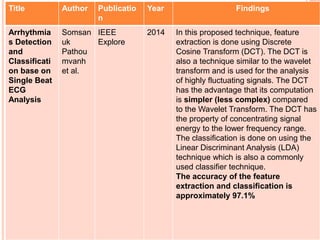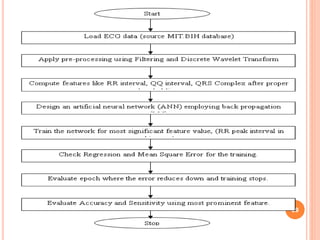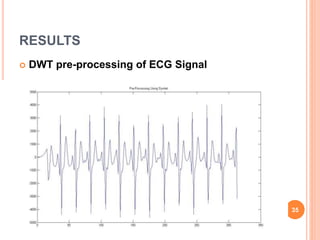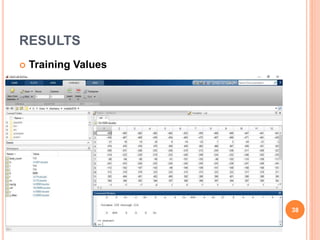Ecg beat classification and feature extraction using artificial neural network and discrete wavelet transform
- 1. ECG BEAT CLASSIFICATION AND FEATURE EXTRACTION USING ARTIFICIAL NEURAL NETWORK AND DISCRETE WAVELET TRANSFORM. Submitted to Submitted by: Prof.Vaibhav Patel Ms. Priyanka Khabiya Asst.Prof.(CSE) Mtech.Scholar(CSE) NIRT,Bhopal (M.P.) NIRT,Bhopal(M.P.) 1
- 2. CONTENTS Abstract Introduction to Data Mining The Human Cardiac Cycle Problem Description Objective of the Thesis Literature Survey Proposed Work Pre-processing Of ECG Data Artificial Neural Networks The Minimum Distance Or Euclidean Classifier Methodology Of Proposed Work with Flowchart Experimental Setup Results Analysis Conclusion References 2
- 3. ABSTRACT Data Mining has played a crucial role in various fields of data analytics, classification and forecasting. In the proposed work, we have used data mining of ECG data for the analysis and classification of ECG data. The steps execution are ECG data pre-processing, feature extraction and classification. It has been shown that the proposed technique yields substantially higher accuracy and sensitivity compared to previous work. It is hoped that the proposed technique will provide highly accurate classification that would reduce chances of human errors in ECG signal analysis thereby helping save human life. 3
- 4. INTRODUCTION Data Mining is defined as extracting information from huge sets of data. The information or knowledge extracted can be used for any of the following applications: Market Analysis Biomedical Applications Fraud Detection Customer Retention Production Control Science Exploration 4
- 5. INTRODUCTION The electrocardiogram (ECG) signal provides crucial information about the functioning of the heart Cardiac arrhythmia is the condition of irregular or abnormal heart speed or heart beat The heart is unable to pump requisite blood to the body A lack of sufficient or regular blood flow may damage vital organs like the brain, heart, kidney etc and become fatal 5
- 6. INTRODUCTION Challenge: The enormous amount of data ECG signal contains. Random fluctuations of the ECG signal. Difficulty in detecting clear trends in the behavior of ECG signals. These challenges can be overcome using sophisticated tools like artificial neural networks. 6
- 7. THE HUMAN CARDIAC CYCLE 7
- 8. THE HUMAN CARDIAC CYCLE Heart follows a regular pattern for pumping blood The regular motion is periodic Sodium and Potassium salts in the blood stream results in the generation of weak electrical signals called electrocardiogram (ECG) signals ECG follows a regular pattern The peaks are named as P,Q,R,S,T waves and the separation between the peaks are named as PR segment, QT segment, QRS Complex, RR segment observed 8
- 9. THE HUMAN CARDIAC CYCLE Segments or intervals yield vital information about the functioning of the heart Segments are called ECG features Estimation of these features is called Feature Extraction Unprocessed ECG signal contains different disturbances called noise Disturbances need to be removed and technique is called data pre-processing 9
- 10. PROBLEM DESCRIPTION The problem description can be stated as follows: ECG signals are extremely random in nature and generally contain effects of noise and random fluctuations. Smoothening out the effects of noise and fluctuations prior to feature extraction is challenging. Feature values need to be critically computed since they play a decisive role in further classification of different ECG cases. Due to the above mentioned reasons, obtaining a high value of sensitivity and accuracy is a serious challenge for ECG signals. 10
- 11. OBJECTIVE OF THE THESIS The objective of the proposed work is to: Effectively pre-process ECG signals prior to feature extraction. Design an accurate feature extraction mechanism that would accurately extract features exhibiting high regression (near unity). Accurately classify the different ECG categories to attain high sensitivity and accuracy. 11
- 12. LITERATURE SURVEY Title Author Publication Year Findings A Patient- Adaptive Profiling Scheme for ECG Beat Classific ation Miad Faezipo ur et al. IEEE Transactions on Information Technology in Biomedicine 2010 In this paper, Wavelet Transform has been applied on the ECG signal before the feature extraction stage. Wavelet Transform is a mathematical technique that converts a signal into different frequency bands. Frequency band means a range of frequencies. From theory of wavelet transform, we come to know that analysis of highly fluctuating signals like ECG signals is can be efficiently done using Wavelet Transform. Normal Fourier Transform is not suitable for the analysis of highly fluctuating signals like ECG signals. The accuracy of the feature extraction and classification is approximately 97.4%
- 13. Title Author Publicati on Year Findings ECG arrhythmia recognitio n via a neuro- SVM–KNN hybrid classifier with virtual QRS image- based geometric al features M.R. Homaei nezhad et al. Elsevier 2012 In this proposed work, ECG arrhythmia (a common category of heart diseases) recognition and classification is proposed using Wavelet Transform and a combined classification technique of Neuro Support Vector Machine (SVM) and Knowledge Neural Network (KNN) is used. The only feature used for classification is the Q-R-S duration or the QRS Complex. While the QRS complex is used for feature extraction, the hybrid technique is used for feature classification of the particular type of disease. The accuracy of the feature extraction and classification is approximately 98.06%
- 14. Title Author Publicatio n Year Findings Arrhythmia s Detection and Classificati on base on Single Beat ECG Analysis Somsan uk Pathou mvanh et al. IEEE Explore 2014 In this proposed technique, feature extraction is done using Discrete Cosine Transform (DCT). The DCT is also a technique similar to the wavelet transform and is used for the analysis of highly fluctuating signals. The DCT has the advantage that its computation is simpler (less complex) compared to the Wavelet Transform. The DCT has the property of concentrating signal energy to the lower frequency range. The classification is done on using the Linear Discriminant Analysis (LDA) technique which is also a commonly used classifier technique. The accuracy of the feature extraction and classification is approximately 97.1%
- 15. Title Author Publicatio n Year Findings Heartbea t classifica tion using disease- specific feature selection Zhanche ng Zhang et al. Elsevier (Computer s in Science and Medicine) 2014 In this technique, peak detection technique is used. Subsequently feature extraction is implemented. There is a modification that is done to the signal before feature extraction. The signals peaks or peak durations are flatted out before feature extraction. For classification, the support vector machine (SVM)is used. The SVM is a discriminative classifier i.e. it discriminates or separates or classifies different values or classes once supervised training is provided. Supervised learning or training is estimating the neural network function from the data provided to the neural network. The accuracy of the feature extraction and classification is approximately 98.98%
- 16. PROPOSED WORK The proposed work contains various steps which are mentioned sequentially: Data mining of ECG data. Pre-processing of ECG data. Feature extraction of ECG data. Designing an Artificial Neural Network and training it with extracted feature values. Using the Euclidean Classifier to classify the different ECG cases. A comprehensive description of each of the above steps is given in the forthcoming slides. 16
- 17. PRE-PROCESSING OF ECG DATA We have used the Discrete Wavelet Transform (DWT) to remove the irregularities in the ECG signal 17
- 18. PRE-PROCESSING OF ECG DATA The mathematical description of the wavelet transform can be given by: C (S, P) = Here S stands for scaling P stands for position t stands for time shifts. C is the Continuous Wavelet Transform (CWT) 18
- 19. PRE-PROCESSING OF ECG DATA The scaling function can be defined as: WΦ (Jo, k) = The Wavelet function can be defined as: = 19
- 20. PRE-PROCESSING OF ECG DATA The Haar Wavelet The Symlet The DB Wavelet 20
- 21. ARTIFICIAL NEURAL NETWORKS Highly Non Linear Structure Highly Parallel Structure 21
- 22. ARTIFICIAL NEURAL NETWORKS The structure can be mathematically modeled as: Here X represents the signal W represents the weight Ɵ represents the bias 22
- 24. ARTIFICIAL NEURAL NETWORKS Concept of Back Propagation 24
- 25. THE MINIMUM DISTANCE OR EUCLIDEAN CLASSIFIER Euclidean Distance defined as: Here x, y and z belong to a vector space C Let the separation of a new sample from the mean value of a particular category be Di We estimate Min (Di) to categorize the data into classes 25
- 26. THE MINIMUM DISTANCE OR EUCLIDEAN CLASSIFIER True Positive (TP): when a sample belongs to category and predicts its belongingness True Negative (TN): when a sample does not belong to category and predicts its non- belongingness. False Positive (FP): when a sample does not belong to category and predicts its belongingness. False Negative (FN): when a sample belongs to category and predicts its non-belongingness. 26
- 27. THE MINIMUM DISTANCE OR EUCLIDEAN CLASSIFIER Sensitivity (Se): It is mathematically defined as: Accuracy (Ac): It is mathematically defined as: 27
- 28. METHODOLOGY OF PROPOSED WORK Step1. Load ECG data (source MIT.BIH database) Step2. Pre-Process Signal using Discrete Wavelet Transform Step3. Compute features like RR interval, QQ interval, QRS Complex after proper thresholding. Step4. Design an artificial neural network (ANN) employing back propagation (LM) Step5. Train the network for most significant feature value, (RR peak interval in this case) Step6. Check Regression and Mean Square Error for the training. Step7. Evaluate epoch where the error reduces down and training stops. Step8. Evaluate Accuracy and Sensitivity using most prominent feature. 28
- 29. 29
- 30. EXPERIMENTAL SETUP The experimental setup for the proposed technique requires loading ECG data into the MATLAB application. MATLAB (Matrix Laboratory) has been chosen as the tool for the Simulation since it contains several in built mathematical functions and effective in-built graphics for ease of complex computation. Here MATLAB-14 has been used as the Simulation Tool. 30
- 31. RESULT ANALYSIS Original ECG Signal 31
- 32. RESULTS ECG Signal after Filtering 32
- 33. RESULTS Wavelet Decomposition of Original ECG Signal at Sym5 33
- 34. RESULTS Smoothening Effect of DWT 34
- 35. RESULTS DWT pre-processing of ECG Signal 35
- 36. RESULTS Design of Neural Network 36
- 42. RESULTS 42
- 43. RESULTS Error Histogram while Training 43
- 44. CONCLUSION Proposed technique is efficient in feature extraction and classification and attains high levels of sensitivity and accuracy. It can be attributed to the fact that data is pre-processed using DWT to smoothen out fluctuations Better training yields accurate results as seen from the regression and error plots The sensitivity and accuracy values validate the efficiency of the proposed technique 44
- 45. REFERENCES [1] Abdelhaq Ouelli, Belachir Elhadadi, Belaid bouikhalene,” Multivariate Autoregressive Modelingfor Cardiac Arrhythmia Classification Using Multilayer Perceptron Neural Networks” 2014 , IEEE,978-1-4799-3824- 7/14. [2] Somsanuk Pathoumvanh, Kazuhiko Hamamoto, Phoumy Indahak,”Arrhythmias Detection And Classification Base On Single Beat Ecg Analysis”, 4th Joint International Conference on Information and Communication Technology, Electronic and Electrical Engineering (JICTEE-2014) [3] Rashad Ahmed, Samer Arafat,”Cardiac Arrhythmia Classification Using Hierarchical Classification Model”, 2014 6th International Conference on CSIT. [4] Pathrawut Klaynin, Waranyu Wongseree, Adisorn Leelasantitham ,Supaporn Kiattisin,”An Electrocardiogram Classification Method Based On Neural Network”,2013 Biomedical Engineering International Conference (BMEiCON-2013). 45
- 46. [5] Nurul Hikmah Kamaruddin, M.Murugappan, Mohammad Iqbal Omar,” Early Prediction Of Cardiovascular Diseases Using Ecg Signal: Review”, 2012 IEEE Student Conference on Research and Development. [6] Manab Kumar Das, Student Member, IEEE, Dipak Kumar Ghosh, Samit Ari, Member, IEEE,” Electrocardiogram (Ecg) Signal Classification Using S-Transform, Genetic Algorithm And Neural Network”, 2013 IEEE 1st International Conference on Condition Assessment Techniques in Electrical Systems. [7] Bushra Mehdi, Tahmina Khan, Zain Anwar Ali,” Artificial Neural Network Based Electrocardiography Analyzer”, 2013 IEEE [8] Shameer Faziludeen1, Sabiq P.V,” Ecg Beat Classification Using Wavelets And Svm”, Proceedings of 2013 IEEE Conference on Information and Communication Technologies (ICT 2013). 46
- 47. o [9] A. Amann, R. Tratnig, and K. Unterkofler, “Detecting ventricular fibrillation by time-delay methods,” IEEE Trans. Biomed. Eng., vol. 54, no. 1, pp. 174 –177, Jan. 2007. o [10] A. Amann, R. Tratnig, and K. Unterkofler, “A new ventricular fibrillation detection algorithm for automated external defibrillators,” in Proc. Comput. Cardiol., Sep. 2005, pp. 559–562. o [11] H. Li, W. Han, C. Hu, and M.-H. Meng, “Detecting ventricular fibrillation by fast algorithm of dynamic sample entropy,” in Proc. IEEE Int. Conf. Robot. Biomimet., Dec. 2009, pp. 1105–1110 o [12] R. H. Clayton, A. Murray, and R. W. Campbell, “Recognition of ventricular fibrillation using neural networks,” Med. Biolog. Eng. Comput., vol. 32, no. 2, pp. 217–220, Mar. 1994 47













































![REFERENCES
[1] Abdelhaq Ouelli, Belachir Elhadadi, Belaid bouikhalene,” Multivariate
Autoregressive Modelingfor Cardiac Arrhythmia Classification Using
Multilayer Perceptron Neural Networks” 2014 , IEEE,978-1-4799-3824-
7/14.
[2] Somsanuk Pathoumvanh, Kazuhiko Hamamoto, Phoumy
Indahak,”Arrhythmias Detection And Classification Base
On Single Beat Ecg Analysis”, 4th Joint International Conference on
Information and Communication Technology, Electronic and Electrical
Engineering (JICTEE-2014)
[3] Rashad Ahmed, Samer Arafat,”Cardiac Arrhythmia Classification
Using Hierarchical Classification Model”, 2014 6th International
Conference on CSIT.
[4] Pathrawut Klaynin, Waranyu Wongseree, Adisorn Leelasantitham
,Supaporn Kiattisin,”An Electrocardiogram Classification Method
Based On Neural Network”,2013 Biomedical Engineering International
Conference (BMEiCON-2013).
45](https://image.slidesharecdn.com/ecgbeatclassificationandfeatureextractionusingartificialneuralnetworkanddiscretewavelettransform-170901081135/85/Ecg-beat-classification-and-feature-extraction-using-artificial-neural-network-and-discrete-wavelet-transform-45-320.jpg)
![ [5] Nurul Hikmah Kamaruddin, M.Murugappan, Mohammad Iqbal
Omar,” Early Prediction Of Cardiovascular Diseases Using Ecg
Signal: Review”, 2012 IEEE Student Conference on Research and
Development.
[6] Manab Kumar Das, Student Member, IEEE, Dipak Kumar Ghosh,
Samit Ari, Member, IEEE,” Electrocardiogram (Ecg) Signal
Classification Using S-Transform, Genetic Algorithm And Neural
Network”, 2013 IEEE 1st International Conference on Condition
Assessment Techniques in Electrical Systems.
[7] Bushra Mehdi, Tahmina Khan, Zain Anwar Ali,” Artificial Neural
Network Based Electrocardiography Analyzer”, 2013 IEEE
[8] Shameer Faziludeen1, Sabiq P.V,” Ecg Beat Classification Using
Wavelets And Svm”, Proceedings of 2013 IEEE Conference on
Information and Communication Technologies (ICT 2013).
46](https://image.slidesharecdn.com/ecgbeatclassificationandfeatureextractionusingartificialneuralnetworkanddiscretewavelettransform-170901081135/85/Ecg-beat-classification-and-feature-extraction-using-artificial-neural-network-and-discrete-wavelet-transform-46-320.jpg)
![o [9] A. Amann, R. Tratnig, and K. Unterkofler, “Detecting ventricular
fibrillation by time-delay methods,” IEEE Trans. Biomed. Eng., vol.
54, no. 1, pp. 174 –177, Jan. 2007.
o [10] A. Amann, R. Tratnig, and K. Unterkofler, “A new ventricular
fibrillation detection algorithm for automated external defibrillators,” in
Proc. Comput. Cardiol., Sep. 2005, pp. 559–562.
o [11] H. Li, W. Han, C. Hu, and M.-H. Meng, “Detecting ventricular
fibrillation by fast algorithm of dynamic sample entropy,” in Proc.
IEEE Int. Conf. Robot. Biomimet., Dec. 2009, pp. 1105–1110
o [12] R. H. Clayton, A. Murray, and R. W. Campbell, “Recognition of
ventricular fibrillation using neural networks,” Med. Biolog. Eng.
Comput., vol. 32, no. 2, pp. 217–220, Mar. 1994
47](https://image.slidesharecdn.com/ecgbeatclassificationandfeatureextractionusingartificialneuralnetworkanddiscretewavelettransform-170901081135/85/Ecg-beat-classification-and-feature-extraction-using-artificial-neural-network-and-discrete-wavelet-transform-47-320.jpg)
